医学专业英语试题
- 格式:doc
- 大小:73.00 KB
- 文档页数:15
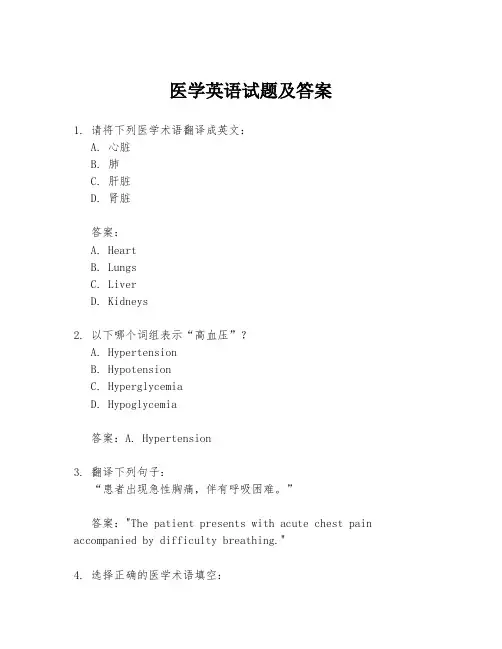
医学英语试题及答案1. 请将下列医学术语翻译成英文:A. 心脏B. 肺C. 肝脏D. 肾脏答案:A. HeartB. LungsC. LiverD. Kidneys2. 以下哪个词组表示“高血压”?A. HypertensionB. HypotensionC. HyperglycemiaD. Hypoglycemia答案:A. Hypertension3. 翻译下列句子:“患者出现急性胸痛,伴有呼吸困难。
”答案:"The patient presents with acute chest pain accompanied by difficulty breathing."4. 选择正确的医学术语填空:A. DiabetesB. HypertensionC. HypothyroidismD. Anemia他被诊断为一种慢性疾病,需要终身服用药物来控制血压。
答案:B. Hypertension5. 请解释“Cardiopulmonary Resuscitation (CPR)”的含义。
答案:Cardiopulmonary Resuscitation (CPR) 是一种紧急医疗程序,用于在心脏骤停时恢复某人的呼吸和血液循环。
6. 将下列医学缩写翻译成完整的医学术语:A. MRIB. CTC. ECGD. MRI答案:A. Magnetic Resonance ImagingB. Computed TomographyC. ElectrocardiogramD. Magnetic Resonance Imaging (重复项,应替换为其他缩写)7. 阅读下列段落并回答问题:The patient was admitted to the hospital with a diagnosis of acute appendicitis. An emergency appendectomy was performed, and the patient is now recovering in the postoperative ward.问:患者接受了哪种紧急手术?答案:患者接受了紧急阑尾切除术。
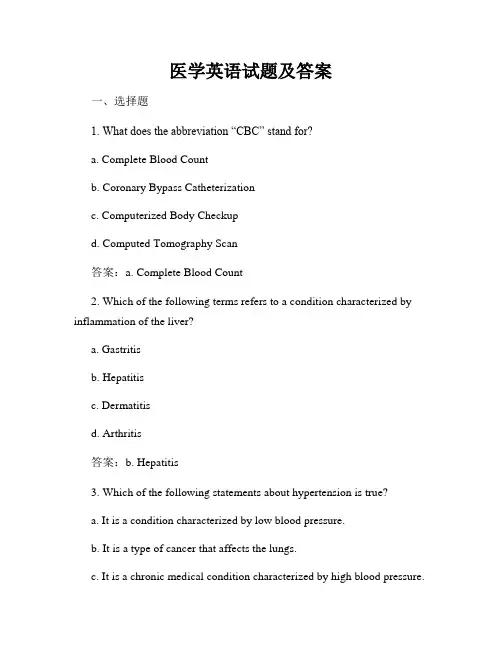
医学英语试题及答案一、选择题1. What does the abbreviation “CBC” stand for?a. Complete Blood Countb. Coronary Bypass Catheterizationc. Computerized Body Checkupd. Computed Tomography Scan答案:a. Complete Blood Count2. Which of the following terms refers to a condition characterized by inflammation of the liver?a. Gastritisb. Hepatitisc. Dermatitisd. Arthritis答案:b. Hepatitis3. Which of the following statements about hypertension is true?a. It is a condition characterized by low blood pressure.b. It is a type of cancer that affects the lungs.c. It is a chronic medical condition characterized by high blood pressure.d. It is an infectious disease caused by a bacterial infection.答案:c. It is a chronic medical condition characterized by high blood pressure.4. What does the abbreviation “MRI” stand for?a. Medical Respiratory Infectionb. Magnetic Resonance Imagingc. Myocardial Infarctiond. Malignant Renal Impairment答案:b. Magnetic Resonance Imaging5. Which of the following organs is responsible for filtering waste products from the blood?a. Liverb. Kidneyc. Stomachd. Lungs答案:b. Kidney二、填空题1. The study of cells is known as ________.答案:Cytology2. The branch of medicine that deals with the diagnosis and treatment of diseases of the heart and blood vessels is called ________.答案:Cardiology3. The largest organ in the human body is the ________.答案:Skin4. The condition characterized by the inability to see in dim light is called ________.答案:Night blindness5. The abbreviation COPD stands for ________.答案:Chronic Obstructive Pulmonary Disease三、简答题1. What is the function of red blood cells in the human body?答案:The function of red blood cells is to transport oxygen from the lungs to the body tissues and carry carbon dioxide back to the lungs for elimination.2. Define the term "antibiotic resistance."答案:Antibiotic resistance refers to the ability of bacteria or other microorganisms to resist the effects of antibiotics, making them ineffective in treating infections caused by these resistant organisms.3. What are the symptoms of a heart attack?答案:The symptoms of a heart attack may include chest pain or discomfort, shortness of breath, pain or discomfort in the arms, jaw, neck, or back, nausea, lightheadedness, and cold sweats.4. Name three ways to prevent the spread of infectious diseases.答案:Three ways to prevent the spread of infectious diseases are proper hand hygiene (such as washing hands with soap and water or using hand sanitizer), covering the mouth and nose when coughing or sneezing, and getting vaccinated.5. What are the four main types of tissue in the human body?答案:The four main types of tissue in the human body are epithelial tissue, connective tissue, muscle tissue, and nervous tissue.四、解释题1. Explain the concept of "herd immunity."答案:Herd immunity refers to a situation where a large proportion of a population is immune to a particular infectious disease, either through vaccination or previous exposure to the disease. When a significant portion of the population is immune, it reduces the likelihood of the disease being transmitted to individuals who are not immune, thus providing indirect protection to the entire community.2. What is the difference between a virus and a bacteria?答案:The main difference between a virus and a bacteria is that viruses are considered non-living entities that require a host cell to replicate, whilebacteria are single-celled microorganisms capable of reproducing on their own. Additionally, bacteria can be treated with antibiotics, whereas viruses cannot.3. Describe the process of mitosis.答案:Mitosis is a type of cell division that occurs in somatic cells and results in the formation of two genetically identical daughter cells. The process involves several stages, including prophase (chromosomes condense and become visible), metaphase (chromosomes align in the middle of the cell), anaphase (chromosomes separate and move to opposite poles), and telophase (nuclear membranes form around the separated chromosomes, and the cell divides).4. What is the purpose of an ECG (electrocardiogram)?答案:An ECG is a medical test that measures the electrical activity of the heart. It is used to diagnose and monitor various heart conditions, such as arrhythmias, heart attacks, and abnormalities in heart structure. The test records the electrical signals produced by the heart and displays them as a waveform on a graph, allowing healthcare professionals to evaluate the heart's rhythm and function.5. Define the term "acute respiratory distress syndrome (ARDS)."答案:Acute respiratory distress syndrome (ARDS) is a severe lung condition characterized by inflammation and fluid buildup in the lungs, leading to difficulty breathing and low blood oxygen levels. It is often caused by underlying conditions, such as pneumonia or sepsis, and can resultin respiratory failure. Treatment typically involves supportive care, such as mechanical ventilation, and addressing the underlying cause.以上为医学英语试题及答案的内容。
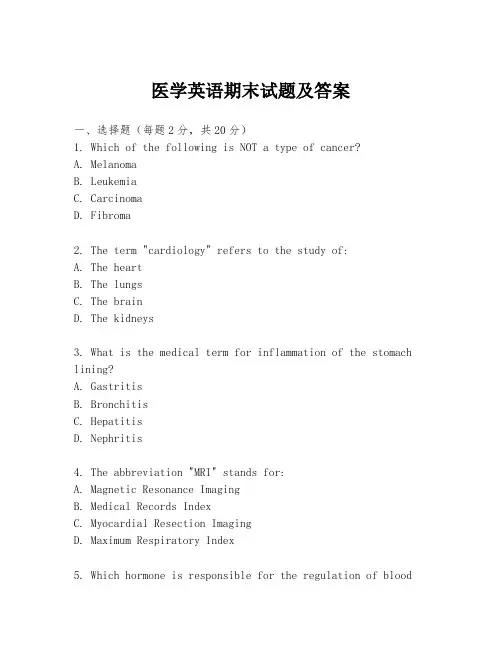
医学英语期末试题及答案一、选择题(每题2分,共20分)1. Which of the following is NOT a type of cancer?A. MelanomaB. LeukemiaC. CarcinomaD. Fibroma2. The term "cardiology" refers to the study of:A. The heartB. The lungsC. The brainD. The kidneys3. What is the medical term for inflammation of the stomach lining?A. GastritisB. BronchitisC. HepatitisD. Nephritis4. The abbreviation "MRI" stands for:A. Magnetic Resonance ImagingB. Medical Records IndexC. Myocardial Resection ImagingD. Maximum Respiratory Index5. Which hormone is responsible for the regulation of bloodsugar levels?A. InsulinB. ThyroxineC. CortisolD. Estrogen6. The process of healing a broken bone is called:A. FractureB. OsteogenesisC. OsteoporosisD. Osteolysis7. A "diagnosis" in medicine is:A. The treatment of a diseaseB. The identification of a diseaseC. The prevention of a diseaseD. The cause of a disease8. What is the medical term for a surgical incision into the chest cavity?A. LaparotomyB. ThoracotomyC. CraniotomyD. Hysterectomy9. The abbreviation "HIV" stands for:A. Human Influenza VirusB. Hepatitis Infection VirusC. Human Immunodeficiency VirusD. Hereditary Immune Virus10. A "pathogen" is:A. A type of medicationB. A disease-causing microorganismC. A symptom of a diseaseD. A preventive measure against disease二、填空题(每空1分,共10分)1. The medical term for the surgical removal of the appendix is __________.2. The study of the nervous system is known as __________.3. A condition characterized by high levels of blood sugar is called __________.4. The process of the body fighting off pathogens is known as __________.5. The abbreviation for the common cold is __________.6. The medical term for inflammation of the heart muscle is __________.7. The medical specialty dealing with the urinary system is __________.8. A person who specializes in the study and treatment of cancer is called an __________.9. The abbreviation for the human papillomavirus is__________.10. A medical condition where the body's immune system attacks its own tissues is known as __________.三、简答题(每题5分,共20分)1. Explain the difference between a virus and a bacterium.2. Describe the function of the thyroid gland.3. What is the purpose of vaccination?4. Define the term "epidemic" and give an example.四、翻译题(每题5分,共20分)1. 翻译以下医学术语:"急性阑尾炎"2. 翻译以下医学术语:"慢性支气管炎"3. 翻译以下医学术语:"高血压"4. 翻译以下医学术语:"糖尿病"五、病例分析题(每题10分,共20分)1. 患者,男性,45岁,主诉胸痛,呼吸困难。
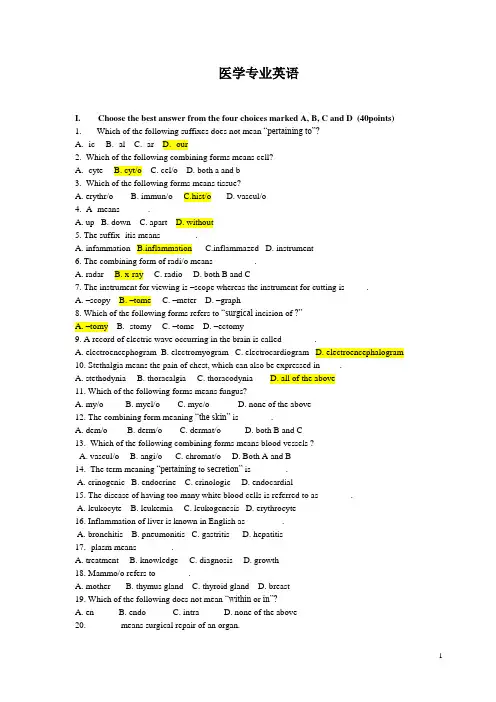
医学专业英语I. Choose the best answer from the four choices marked A, B, C and D (40points)1. Which of the following suffixes does not mean “pertaining to”?A. -icB. -alC. -arD. -our2. Which of the following combining forms means cell?A. -cyteB. cyt/oC. cel/oD. both a and b3. Which of the following forms means tissue?A. erythr/oB. immun/oC.hist/oD. vascul/o4. A- means ______.A. upB. downC. apartD. without5. The suffix -itis means _______ .A. infammationB.inflammationC.inflammazedD. instrument6. The combining form of radi/o means _________.A. radarB. x-rayC. radioD. both B and C7. The instrument for viewing is –scope whereas the instrument for cutting is_____.A. –scopyB. –tomeC. –meterD. –graph8. Which of the following forms refers to “surgical incision of ?”A. –tomyB. -stomyC. –tomeD. –ectomy9. A record of electric wave occurring in the brain is called _______.A. electroencephogramB. electromyogramC. electrocardiogramD. electroencephalogram10. Stethalgia means the pain of chest, which can also be expressed in ____.A. stethodyniaB. thoracalgiaC. thoracodyniaD. all of the above11. Which of the following forms means fungus?A. my/oB. myel/oC. myc/oD. none of the above12. The combining form meaning “the skin” is _______.A. dem/oB. derm/oC. dermat/oD. both B and C13. Which of the following combining forms means blood vessels ?A. vascul/oB. angi/oC. chromat/oD. Both A and B14. The term meaning “pertaining to secretion” is _______ .A. crinogenicB. endocrineC. crinologicD. endocardial15. The disease of having too many white blood cells is referred to as _______.A. leukocyteB. leukemiaC. leukogenesisD. erythrocyte16. Inflammation of liver is known in English as ________.A. bronchitisB. pneumonitisC. gastritisD. hepatitis17. -plasm means _______.A. treatmentB. knowledgeC. diagnosisD. growth18. Mammo/o refers to _______.A. motherB. thymus glandC. thyroid glandD. breast19. Which of the following does not mean “within or in”?A. en-B. endo-C. intra-D. none of the above20. _______ means surgical repair of an organ.A. phag/oB. –plasmC. –plastyD. –pathy21. Spir/o is a combining form meaning ______.A. seeB. sightC. breathD. sport22. Inflammation of lungs is known as _______.A. pneumonitisB. pneumoniaC. pulmonitisD. All of the above23. Which of the following forms means “p rotection or safe” ?A. immun/oB. lymph/oC. erythr/oD. None of the above24. Cardiopathy means _________.A. heart failureB. heart diseaseC. brain diseaseD. skeletal disease25.Which of the following combining forms does not refer to an organ?A. hepat/oB. gastr/oC. psych/oD. nephr/o26. The color of something best expressed in medical terminology is _______.A. chrom/oB. chromomat/oC. chramat/oD. Both A and B27. Which of the following means “instrument for measuring”?A. -graphB. -tomeC. –meterD. -scope28. Bi- means ______.A. lifeB. twoC. acrossD. Both A and B29. The form meaning arteries is ________.A. arter/oB. arteri/oC. arthr/oD.artheri/o30. The prefix with the meaning of bad is ______.A. mal-B. dys-C. polio-D. Both A and B31. The flesh is expressed in the combining form of _______.A. top/oB. ten/oC.thym/oD. sarc/o32. The combining vowel for angitis is ____________.A. aB. oC. eD.i33. Hypo- means having _______ of something.A. too much or too highB. too little or too lowC. overD. below34. Morph/o means ______.A. manyB. maxillaeC. shapeD. head35. “Pertaining to nourishment or development” is expressed in _________.A. –tropyB. –trophyC.- tropicD.-trophic36. The process of recording sth is expressed in _________.A. -graphB. -gramC. -graphyD.-scope37. The formation of blood is also known as ______.A. hematopoiesisB. hemopoiesisC.homopoiesisD. both A and B38. Because the strands are readily stained with dyes, they are called_______.A. chromosomesB. protoplasmsC. cytoplasmsD.chromatins39.The science that deals with cells on the smallest structural and functional level is called _____.A. biologyB. microbiologyC. homostasisD. molecular biology40. An instrument for measuring the cell counts of red blood cells is an _______.A. erythrocyteB. erythrogenesisC. erythrocytometerD. erythrocytographII. Find the best answer to the following abbreviations. (10 points)41. SARSA. Serious Acute Respiratary SyndromeB. Severe Acute Respiration SystemC. Severe Acute Respiratory SyndromeD. Severe Acute Respiratary Syndrome42. T.BA. tuberclosisB. tubercluosisC. tubaclosisD. tuberculosis43. IgA.immunoglobinB. immunogloblinC. immunoglobulinD. immunoglubin44. RNAA. ribonuclear acidB. ribanucleic acidC. ribanucleic acidD. ribonucleic acidGA. ultrosonograhyB. ultrasonograhyC. ultrosonographyD. ultrasonography46.ECGA. electrocardiogramB. electrocardiographyC. electroencephogramD. electroencephalogram47. CTA. computed tomograhyB. computed tomographyC. computerized tomograhyD. computerized tom ography48. MRIA. Magnetic resononce imageB. Magnetic resonance imageC. Magnetic resononce imagingD. Magnetic resonance imaging49.VDA. varied diseaseB. venareal diseaseC. venereal diseaseD. vocal disease50. GIA. gastrointral tractB. gastrointervention tractC. gastrointestinal tractD. gastrointersectional tract III. Find the best answer to the following translations. (10 points)51. 心血管疾病A. cardiavasclar diseaseB. cardiavascular diseaseC. cardiovasclar diseaseD. cardiovascular dise ase52.随意肌A. voluntary muscleB. involuntary muscleC. smooth muscleD. cardiac muscle53 脉冲信号A. pulseB. impulseC. impulsiveD. pulsive54. 转换A. transformationB. transactionC. transmuteD. transmission55.功能失调A. malfunctionB. dysfunctionC. maloperationD. disoperation56. 局部化的感染A. local infectionB. localized infectionC. local inflammationD. localized inflammation57.乐观的预后A. optimistic pregnosisB. optimistic prognosisC. pessimistic pregnosisD. pessimistic prognosis58. 光纤技术A. optic fiber technologyB. fiber optic techonologyC. fiber optic technologyD. optic fiber techonology59. 肌肉收缩A. muscle contractionB. muscular contractionC..musclar contractionD. Both A and B60. 血供A. supply blood B. blood supply C. protein molecule D. extensorIV. Translate the following into Chinese. (40 points)61. Hundreds of different diseases exist. Each has its own particular set of symptoms and signs, clues that enable a physician to diagnose the problem. A symptom is something a patient can detect, such as fever, bleeding, or pain. A sign is something a doctor can detect, such as a swollen blood vessel or a n enlarged internal body organ.62. All cells consist of protoplasm, the “living jelly”. The protoplasm of a typical cell forms three vitalparts --- the cell membrane, the cytoplasm, and the nucleus. The membrane encloses the other cell st ructures. Much of the chemical work of the cell is done in the cytoplasm, which surrounds the nucle us. The nucleus, enclosed by its own membrane, is the control center of the cell.1.D2.B3. C4. D5. B6. B7. B8.A9. D 10.D11.C 12.D 13. D 14.A 15. B 16. D 17. D 18.D 19. D 20.C21.C 22.D 23. A 24. B 25. C 26. A 27. C 28.B 29. B 30.D31.D 32.B 33. B 34.C 35. D 36. C 37. D 38.D 39. D 40.C41.C 42.D 43. C 44. D 45. D 46. A 47. B 48.D 49. C 50.C51.D 52.A 53. B 54.B 55. A 56. B 57.B 58.C 59. D 60.B61. 疾病有成百上千种。
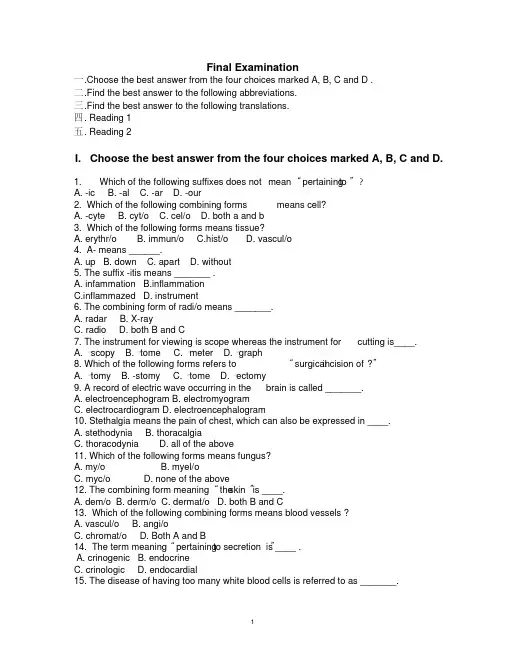
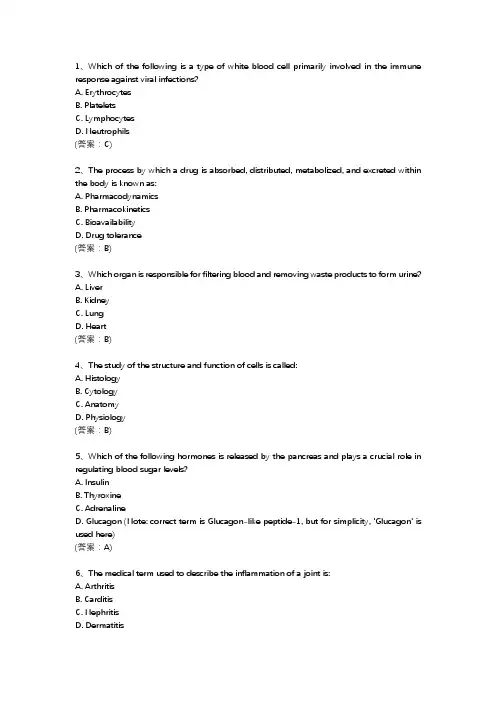
1、Which of the following is a type of white blood cell primarily involved in the immune response against viral infections?A. ErythrocytesB. PlateletsC. LymphocytesD. Neutrophils(答案:C)2、The process by which a drug is absorbed, distributed, metabolized, and excreted within the body is known as:A. PharmacodynamicsB. PharmacokineticsC. BioavailabilityD. Drug tolerance(答案:B)3、Which organ is responsible for filtering blood and removing waste products to form urine?A. LiverB. KidneyC. LungD. Heart(答案:B)4、The study of the structure and function of cells is called:A. HistologyB. CytologyC. AnatomyD. Physiology(答案:B)5、Which of the following hormones is released by the pancreas and plays a crucial role in regulating blood sugar levels?A. InsulinB. ThyroxineC. AdrenalineD. Glucagon (Note: correct term is Glucagon-like peptide-1, but for simplicity, 'Glucagon' is used here)(答案:A)6、The medical term used to describe the inflammation of a joint is:A. ArthritisB. CarditisC. NephritisD. Dermatitis(答案:A)7、Which of the following imaging techniques uses high-frequency sound waves to produce images of internal body structures?A. X-rayB. CT scanC. UltrasoundD. MRI(答案:C)8、The process of converting food into energy that the body can use is known as:A. DigestionB. MetabolismC. AbsorptionD. Assimilation(答案:B)9、Which vitamin is essential for maintaining healthy bones and teeth, and is primarily obtained from sunlight exposure?A. Vitamin AB. Vitamin CC. Vitamin DD. Vitamin K(答案:C)10、The branch of medicine that deals with the prevention, diagnosis, and treatment of diseases of the heart and blood vessels is called:A. NeurologyB. CardiologyC. DermatologyD. Gastroenterology(答案:B)。
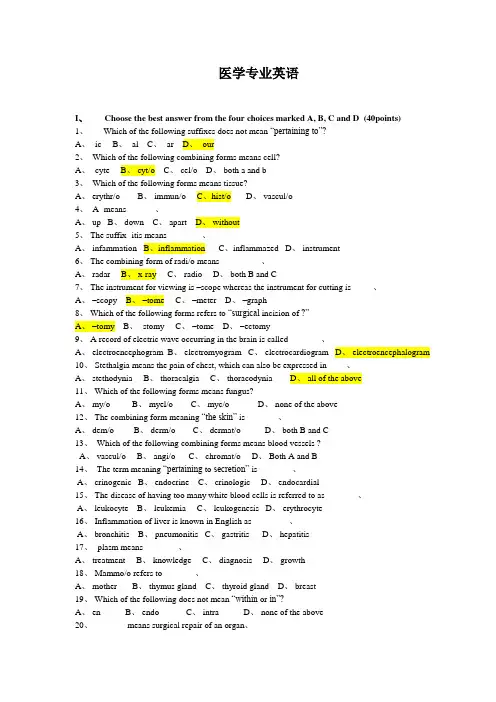
医学专业英语I、 Choose the best answer from the four choices marked A, B, C and D (40points)1、 Which of the following suffixes does not mean “pertaining to”?A、 -icB、 -alC、 -arD、 -our2、 Which of the following combining forms means cell?A、 -cyteB、 cyt/oC、 cel/oD、 both a and b3、 Which of the following forms means tissue?A、 erythr/oB、 immun/oC、hist/oD、 vascul/o4、 A- means ______、A、 upB、 downC、 apartD、 without5、 The suffix -itis means _______ 、A、 infammationB、inflammationC、inflammazedD、 instrument6、 The combining form of radi/o means _________、A、 radarB、 x-rayC、 radioD、 both B and C7、 The instrument for viewing is –scope whereas the instrument for cutting is_____、A、–scopyB、–tomeC、–meterD、–graph8、 Which of the following forms refers to “surgical incision of ?”A、–tomyB、 -stomyC、–tomeD、–ectomy9、 A record of electric wave occurring in the brain is called _______、A、 electroencephogramB、 electromyogramC、 electrocardiogramD、 electroencephalogram10、 Stethalgia means the pain of chest, which can also be expressed in ____、A、 stethodyniaB、 thoracalgiaC、 thoracodyniaD、 all of the above11、 Which of the following forms means fungus?A、 my/oB、 myel/oC、 myc/oD、 none of the above12、 The combining form meaning “the skin” is _______、A、 dem/oB、 derm/oC、 dermat/oD、 both B and C13、 Which of the following combining forms means blood vessels ?A、 vascul/oB、 angi/oC、 chromat/oD、 Both A and B14、 The term meaning “pertaining to secretion” is _______ 、A、 crinogenicB、 endocrineC、 crinologicD、 endocardial15、 The disease of having too many white blood cells is referred to as _______、A、 leukocyteB、 leukemiaC、 leukogenesisD、 erythrocyte16、 Inflammation of liver is known in English as ________、A、 bronchitisB、 pneumonitisC、 gastritisD、 hepatitis17、 -plasm means _______、A、 treatmentB、 knowledgeC、 diagnosisD、 growth18、 Mammo/o refers to _______、A、 motherB、 thymus glandC、 thyroid glandD、 breast19、 Which of the following does not mean “within or in”?A、 en-B、 endo-C、 intra-D、 none of the above20、 _______ means surgical repair of an organ、A、 phag/oB、–plasmC、–plastyD、–pathy21、 Spir/o is a combining form meaning ______、A、 seeB、 sightC、 breathD、 sport22、 Inflammation of lungs is known as _______、A、 pneumonitisB、 pneumoniaC、 pulmonitisD、 All of the above23、 Which of the following forms means “prote ction or safe” ?A、 immun/oB、 lymph/oC、 erythr/oD、 None of the above24、 Cardiopathy means _________、A、 heart failureB、 heart diseaseC、 brain diseaseD、 skeletal disease25、Which of the following combining forms does not refer to an organ?A、 hepat/oB、 gastr/oC、 psych/oD、 nephr/o26、 The color of something best expressed in medical terminology is _______、A、 chrom/oB、 chromomat/oC、 chramat/oD、 Both A and B27、 Which of the following means “instrument for measuring”?A、 -graphB、 -tomeC、–meterD、 -scope28、 Bi- means ______、A、 lifeB、 twoC、 acrossD、 Both A and B29、 The form meaning arteries is ________、A、 arter/oB、 arteri/oC、 arthr/oD、artheri/o30、 The prefix with the meaning of bad is ______、A、 mal-B、 dys-C、 polio-D、 Both A and B31、 The flesh is expressed in the combining form of _______、A、 top/oB、 ten/oC、thym/oD、 sarc/o32、 The combining vowel for angitis is ____________、A、 aB、 oC、 eD、i33、 Hypo- means having _______ of something、A、 too much or too highB、 too little or too lowC、 overD、 below34、 Morph/o means ______、A、 manyB、 maxillaeC、 shapeD、 head35、“Pertaining to nourishment or development” is expressed in _________、A、–tropyB、–trophyC、- tropicD、-trophic36、 The process of recording sth is expressed in _________、A、 -graphB、 -gramC、 -graphyD、-scope37、 The formation of blood is also known as ______、A、 hematopoiesisB、 hemopoiesisC、homopoiesisD、 both A and B38、 Because the strands are readily stained with dyes, they are called_______、A、 chromosomesB、 protoplasmsC、 cytoplasmsD、chromatins39、The science that deals with cells on the smallest structural and functional level is called _____、A、 biologyB、 microbiologyC、 homostasisD、 molecular biology40、 An instrument for measuring the cell counts of red blood cells is an _______、A、 erythrocyteB、 erythrogenesisC、 erythrocytometerD、 erythrocytographII、 Find the best answer to the following abbreviations、 (10 points)41、 SARSA、 Serious Acute Respiratary SyndromeB、 Severe Acute Respiration SystemC、 Severe Acute Respiratory SyndromeD、 Severe Acute Respiratary Syndrome42、 T、BA、 tuberclosisB、 tubercluosisC、 tubaclosisD、 tuberculosis43、 IgA、immunoglobinB、 immunogloblinC、 immunoglobulinD、 immunoglubin44、 RNAA、 ribonuclear acidB、 ribanucleic acidC、 ribanucleic acidD、 ribonucleic acid45、USGA、 ultrosonograhyB、 ultrasonograhyC、 ultrosonographyD、 ultrasonography46、ECGA、 electrocardiogramB、 electrocardiographyC、 electroencephogramD、 electroencephalogram47、 CTA、 computed tomograhyB、 computed tomographyC、 computerized tomograhyD、 computeri zed tomography48、 MRIA、 Magnetic resononce imageB、 Magnetic resonance imageC、 Magnetic resononce imagingD、 Magnetic resonance imaging49、VDA、 varied diseaseB、 venareal diseaseC、 venereal diseaseD、 vocal disease50、 GIA、 gastrointral tractB、 gastrointervention tractC、 gastrointestinal tractD、 gastrointersectional tractIII、 Find the best answer to the following translations、 (10 points)51、心血管疾病A、 cardiavasclar diseaseB、 cardiavascular diseaseC、 cardiovasclar diseaseD、 cardiovascul ar disease52、随意肌A、 voluntary muscleB、 involuntary muscleC、 smooth muscleD、 cardiac muscle53 脉冲信号A、 pulseB、 impulseC、 impulsiveD、 pulsive54、转换A、 transformationB、 transactionC、 transmuteD、 transmission55、功能失调A、 malfunctionB、 dysfunctionC、 maloperationD、 disoperation56、局部化的感染A、 local infectionB、 localized infectionC、 local inflammationD、 localized inflammation57、乐观的预后A、 optimistic pregnosisB、 optimistic prognosisC、 pessimistic pregnosisD、 pessimistic prognosis58、光纤技术A、 optic fiber technologyB、 fiber optic techonologyC、 fiber optic technologyD、 optic fiber techonology59、肌肉收缩A、 muscle contractionB、 muscular contractionC、、musclar contractionD、 Both A and B60、血供A. supply blood B、 blood supply C、 protein molecule D、 extensorIV、 Translate the following into Chinese、 (40 points)61、 Hundreds of different diseases exist、 Each has its own particular set of symptoms and signs, clues that enable a physician to diagnose the problem、 A symptom is something a patient can detect, su ch as fever, bleeding, or pain、 A sign is something a doctor can detect, such as a swollen blood ves sel or an enlarged internal body organ、62、 All cells consist of protoplasm, the “living jelly”、 The protoplasm of a typical cell forms three vital parts --- the cell membrane, the cytoplasm, and the nucleus、 The membrane encloses the other c ell structures、 Much of the chemical work of the cell is done in the cytoplasm, which surrounds the nucleus、 The nucleus, enclosed by its own membrane, is the control center of the cell、1、D2、B3、 C4、 D5、 B6、 B7、 B8、A9、 D 10、D11、C 12、D 13、 D 14、A 15、 B 16、 D 17、 D 18、D 19、 D 20、C21、C 22、D 23、 A 24、 B 25、 C 26、 A 27、 C 28、B 29、 B 30、D31、D 32、B 33、 B 34、C 35、 D 36、 C 37、 D 38、D 39、 D 40、C41、C 42、D 43、 C 44、 D 45、 D 46、 A 47、 B 48、D 49、 C 50、C51、D 52、A 53、 B 54、B 55、 A 56、 B 57、B 58、C 59、 D 60、B61、疾病有成百上千种。
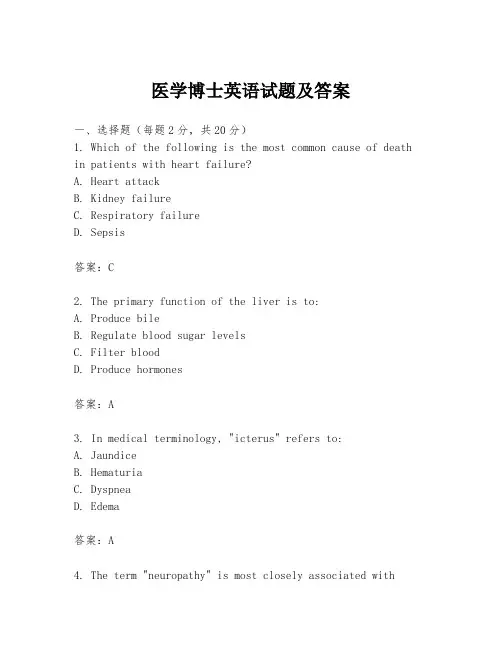
医学博士英语试题及答案一、选择题(每题2分,共20分)1. Which of the following is the most common cause of death in patients with heart failure?A. Heart attackB. Kidney failureC. Respiratory failureD. Sepsis答案:C2. The primary function of the liver is to:A. Produce bileB. Regulate blood sugar levelsC. Filter bloodD. Produce hormones答案:A3. In medical terminology, "icterus" refers to:A. JaundiceB. HematuriaC. DyspneaD. Edema答案:A4. The term "neuropathy" is most closely associated withwhich system of the body?A. Musculoskeletal systemB. Nervous systemC. Cardiovascular systemD. Respiratory system答案:B5. Which of the following is a risk factor for developing diabetes?A. High blood pressureB. Family history of diabetesC. Both A and BD. Neither A nor B答案:C6. The abbreviation "MRI" stands for:A. Magnetic Resonance ImagingB. Myocardial Reperfusion ImagingC. Metabolic Rate ImagingD. Mitochondrial Respiratory Index答案:A7. A patient with a diagnosis of "pneumonia" is most likely to exhibit which symptom?A. CoughB. DiarrheaC. RashD. Headache答案:A8. The "HIV" in medical terminology stands for:A. Human Immunodeficiency VirusB. Hepatitis Infection VirusC. Hemophiliac Infection VirusD. Hypertension Infection Virus答案:A9. Which of the following is a type of cancer that originates in the blood?A. LeukemiaB. MelanomaC. Lung cancerD. Breast cancer答案:A10. The "ICU" in a hospital setting refers to:A. Intensive Care UnitB. Inpatient Care UnitC. Imaging Control UnitD. Infection Control Unit答案:A二、填空题(每题2分,共20分)1. The medical term for inflammation of the heart muscle is ________.答案:cardiomyopathy2. A(n) ________ is a medical professional who specializes in the diagnosis and treatment of diseases of the ear, nose, and throat.答案:otolaryngologist3. The process of removing waste products from the body is known as ________.答案:excretion4. A(n) ________ is a type of cancer that originates in the prostate gland.答案:prostate cancer5. The abbreviation "CT" stands for ________.答案:computed tomography6. A patient with a diagnosis of ________ is experiencing difficulty in breathing.答案:asthma7. The medical term for the surgical removal of the appendix is ________.答案:appendectomy8. A(n) ________ is a medical condition characterized by high blood pressure.答案:hypertension9. The abbreviation "MRI" stands for ________.答案:magnetic resonance imaging10. The term "diabetes" refers to a group of metabolic diseases characterized by high blood ________ levels.答案:glucose三、简答题(每题10分,共20分)1. Explain the difference between a "benign" tumor and a "malignant" tumor.答案:A benign tumor is a growth that does not invade nearby tissue or spread to other parts of the body. It is generally not life-threatening and can often be removed surgically. In contrast, a malignant tumor is cancerous, meaning it can invade and destroy surrounding tissues and spread to other parts of the body through the blood and lymph systems, posing a significant health risk.2. What is the role of the spleen in the human body?答案:The spleen is an important organ in the immune system, primarily responsible for filtering blood and removing damaged cells and bacteria. It also plays a role in the production of white blood cells and the storage of platelets and red blood cells. Additionally, the spleen helps in the recycling of iron from old red blood cells.四、论述题(每题15分,共30分)1. Discuss the importance of a balanced diet in maintaining good health.答案:A balanced diet is crucial for maintaining good health as it provides the body with the necessary nutrients, vitamins, and minerals required for optimal functioning. Ithelps in maintaining a healthy weight, supports the immune system, promotes proper growth and development, and reduces the risk of chronic diseases such as heart disease, diabetes, and certain types of cancer. A balanced diet typically includes a variety of fruits, vegetables, whole grains, lean proteins, and healthy fats, while。
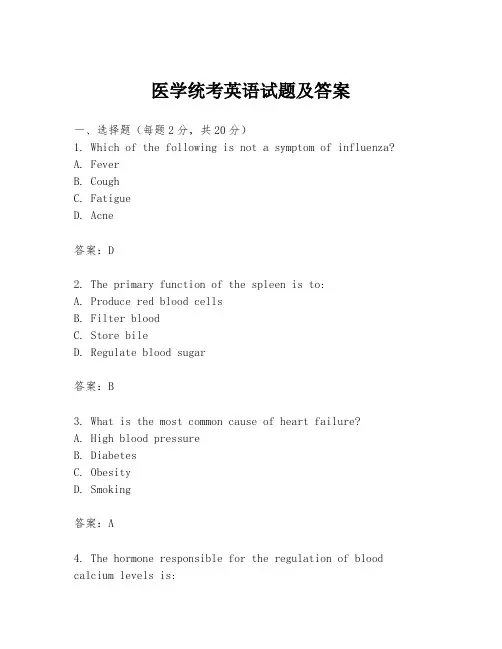
医学统考英语试题及答案一、选择题(每题2分,共20分)1. Which of the following is not a symptom of influenza?A. FeverB. CoughC. FatigueD. Acne答案:D2. The primary function of the spleen is to:A. Produce red blood cellsB. Filter bloodC. Store bileD. Regulate blood sugar答案:B3. What is the most common cause of heart failure?A. High blood pressureB. DiabetesC. ObesityD. Smoking答案:A4. The hormone responsible for the regulation of blood calcium levels is:A. InsulinB. Thyroid hormoneC. Parathyroid hormoneD. Adrenaline答案:C5. Which of the following is a risk factor for developingtype 2 diabetes?A. Regular exerciseB. Healthy dietC. Family history of diabetesD. Low stress levels答案:C6. The process of cell division that results in two identical cells with the same genetic material is called:A. MitosisB. MeiosisC. ApoptosisD. Cytokinesis答案:A7. Which of the following is not a type of autoimmune disease?A. Rheumatoid arthritisB. LupusC. Multiple sclerosisD. Parkinson's disease答案:D8. The main function of the liver is to:A. Produce insulinB. Filter bloodC. Detoxify the bodyD. Regulate body temperature答案:C9. The most common type of cancer in men is:A. Lung cancerB. Prostate cancerC. Colon cancerD. Skin cancer答案:B10. The hormone that stimulates the uterus to contract during childbirth is:A. OxytocinB. EstrogenC. ProgesteroneD. Cortisol答案:A二、填空题(每题2分,共20分)1. The respiratory system is responsible for the exchange of _______ and _______.答案:oxygen, carbon dioxide2. The largest organ in the human body is the _______.答案:skin3. The process of digestion begins in the _______.答案:mouth4. The hormone that stimulates the growth and development of the female reproductive system is _______.答案:estrogen5. The most common type of cancer in women is _______.答案:breast cancer6. The heart is divided into four chambers: two atria and two _______.答案:ventricles7. The nervous system is divided into the central nervous system and the _______ nervous system.答案:peripheral8. The primary function of the kidneys is to _______ the blood and produce urine.答案:filter9. The hormone that regulates blood sugar levels is _______. 答案:insulin10. The most common cause of liver cancer is chronic _______. 答案:hepatitis三、简答题(每题10分,共20分)1. Explain the role of the lymphatic system in the body.答案:The lymphatic system plays a crucial role in maintaining the body's fluid balance and immune function. It is responsible for the circulation of lymph, a fluid containing white blood cells, throughout the body. This system helps to remove waste products, bacteria, and other foreign substances from the tissues and returns the excess fluid to the bloodstream. Additionally, the lymphatic system is integral to the immune response as it contains lymph nodes that filter out harmful substances and produce lymphocytes, which are essential for fighting infections.2. Describe the process of blood clotting.答案:Blood clotting, also known as coagulation, is a complex process that prevents excessive bleeding when a blood vessel is injured. It involves several steps: First, the damaged blood vessel constricts to reduce blood flow. Platelets, small cell fragments in the blood, adhere to the site of injury and aggregate to form a plug. Meanwhile, a series of clotting factors in the blood are activated in a cascade, leading to the conversion of fibrinogen into fibrin. Thefibrin forms a mesh that traps the platelet plug, creating a stable clot. Finally, once the blood vessel has healed, the clot is dissolved by the action of plasmin, an enzyme that breaks down fibrin.。
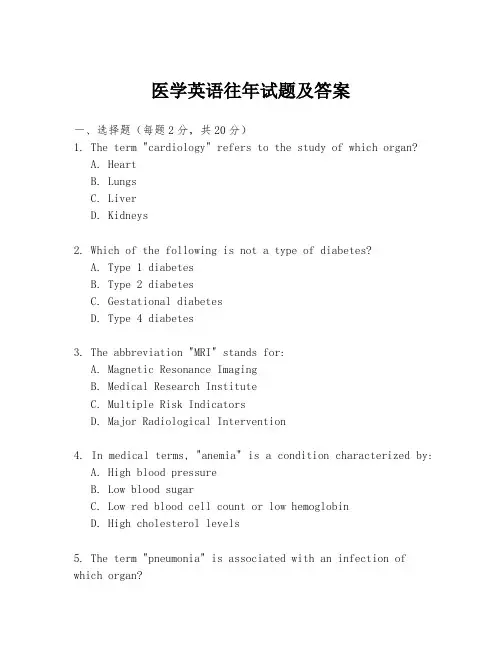
医学英语往年试题及答案一、选择题(每题2分,共20分)1. The term "cardiology" refers to the study of which organ?A. HeartB. LungsC. LiverD. Kidneys2. Which of the following is not a type of diabetes?A. Type 1 diabetesB. Type 2 diabetesC. Gestational diabetesD. Type 4 diabetes3. The abbreviation "MRI" stands for:A. Magnetic Resonance ImagingB. Medical Research InstituteC. Multiple Risk IndicatorsD. Major Radiological Intervention4. In medical terms, "anemia" is a condition characterized by:A. High blood pressureB. Low blood sugarC. Low red blood cell count or low hemoglobinD. High cholesterol levels5. The term "pneumonia" is associated with an infection of which organ?A. HeartB. LungsC. StomachD. Brain6. Which of the following is a common symptom of the common cold?A. DiarrheaB. RashC. CoughD. Jaundice7. The medical abbreviation "OTC" stands for:A. Over the CounterB. Outpatient Treatment CenterC. Occupational Therapy CenterD. Oral Treatment Course8. A "biopsy" is a medical procedure to:A. Remove a sample of tissue for examinationB. Administer medicationC. Perform surgery to remove a tumorD. Examine the blood under a microscope9. The term "epidemic" refers to:A. A sudden increase in the number of cases of a diseaseB. A disease that is present in a communityC. A disease that is endemic to a particular areaD. A disease that has been eradicated10. The abbreviation "HIV" stands for:A. Human Immunodeficiency VirusB. Highly Infectious VirusC. Hepatitis Infection VirusD. Hemophiliac Immune Virus答案:1-5: A, D, A, C, B6-10: C, A, A, A, A二、填空题(每空1分,共10分)1. The medical term for inflammation of the lungs is__________.2. A __________ is a healthcare professional who specializes in the diagnosis and treatment of diseases and injuries of the musculoskeletal system.3. The abbreviation "AIDS" stands for Acquired Immune Deficiency __________.4. The process of medical imaging that uses X-rays to create images of the inside of the body is called __________.5. A __________ is a surgical procedure to remove a diseased or damaged organ or tissue.答案:1. Pneumonitis2. Orthopedist3. Syndrome4. Radiography5. Excision三、简答题(每题5分,共20分)1. What is the difference between a virus and a bacterium?2. Explain the concept of "herd immunity" in the context of public health.3. What is the role of white blood cells in the immune system?4. Describe the function of the thyroid gland.答案:1. A virus is a small infectious agent that can onlyreplicate inside the living cells of an organism, while a bacterium is a single-celled microorganism that can live independently and reproduce by binary fission.2. Herd immunity occurs when a large percentage of apopulation has become immune to an infection, therebyproviding a measure of protection for individuals who are not immune.3. White blood cells play a critical role in defending the body against both infectious disease and foreign invaders. They help to fight off infections by identifying, attacking, and eliminating pathogens.4. The thyroid gland is a butterfly-shaped gland located inthe neck that produces hormones which regulate the body's metabolism, growth, and development.四、翻译题(每题5分,共15分)1. 请将“慢性阻塞性肺病”翻译成英文。
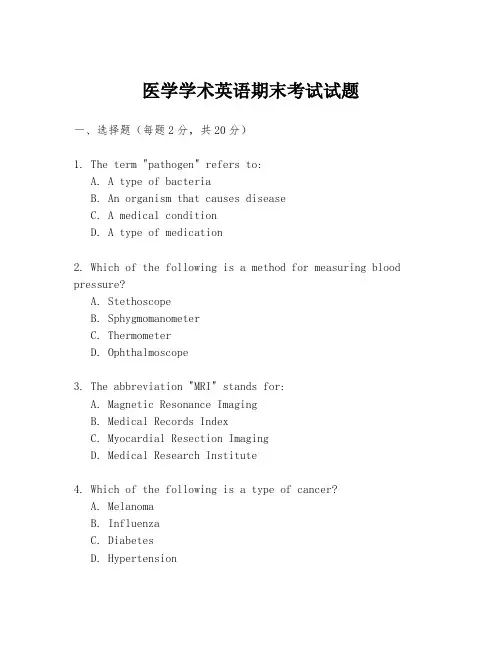
医学学术英语期末考试试题一、选择题(每题2分,共20分)1. The term "pathogen" refers to:A. A type of bacteriaB. An organism that causes diseaseC. A medical conditionD. A type of medication2. Which of the following is a method for measuring blood pressure?A. StethoscopeB. SphygmomanometerC. ThermometerD. Ophthalmoscope3. The abbreviation "MRI" stands for:A. Magnetic Resonance ImagingB. Medical Records IndexC. Myocardial Resection ImagingD. Medical Research Institute4. Which of the following is a type of cancer?A. MelanomaB. InfluenzaC. DiabetesD. Hypertension5. The process of identifying the cause of a disease is known as:A. DiagnosisB. PrognosisC. TreatmentD. Epidemiology二、填空题(每空1分,共20分)6. The medical term for the surgical removal of a tumor is__________.7. The study of the cause and spread of diseases is known as __________.8. The abbreviation "HIV" stands for __________.9. A(n) __________ is a healthcare professional who specializes in the diagnosis and treatment of diseases of the heart.10. The term "antibiotic" refers to a substance that inhibits the growth of __________.三、简答题(每题5分,共30分)11. Explain the difference between a virus and a bacterium.12. Describe the role of white blood cells in the immune system.13. What is the purpose of a biopsy in medical diagnosis?14. Discuss the importance of vaccination in public health.四、阅读理解(每题5分,共30分)Read the following passage and answer the questions:Passage: (A brief excerpt from a medical journal article discussing the latest developments in cancer treatment, including targeted therapies and immunotherapies.)15. What are the two main types of cancer treatment mentioned in the passage?16. How do targeted therapies differ from traditional chemotherapy?17. What is the basic principle behind immunotherapy?18. According to the passage, what are some potential advantages of immunotherapy over other treatments?五、写作题(共30分)19. Write a short essay (200-250 words) on the impact of medical technology on patient care. Discuss at least two specific examples of how technology has improved medical practice.六、翻译题(每题5分,共20分)20. Translate the following sentence into English: "近年来,基因编辑技术在医学研究中的应用越来越广泛。
医学英语考试试题及答案一、选择题(每题1分,共10分)1. Which of the following is a common symptom of the common cold?A. FeverB. CoughC. Both A and BD. Neither A nor B2. The term "cardiology" refers to the study of which organ?A. LiverB. HeartC. LungsD. Kidneys3. What does the abbreviation "MRI" stand for?A. Magnetic Resonance ImagingB. Medical Research InstituteC. Multiple Response IndicatorD. Medical Radiology Institute4. The process of healing a wound is known as:A. InflammationB. RegenerationC. ResectionD. Reabsorption5. Which of the following is not a type of cancer?A. LeukemiaB. MelanomaC. SarcomaD. Fibromyalgia6. The term "diabetes" is related to the body's inability to:A. Excrete wasteB. Regulate blood sugar levelsC. Maintain body temperatureD. Clot blood7. The abbreviation "HIV" stands for:A. Human Immunodeficiency VirusB. High Intensity VirusC. Hemorrhagic Influenza VirusD. Hepatitis Infection Virus8. A "pathogen" is an agent that can cause:A. DiseaseB. GrowthC. RegenerationD. Immunity9. The medical term "anemia" refers to a deficiency of:A. CalciumB. IronC. Vitamin CD. Potassium10. The abbreviation "WHO" stands for:A. World Health OrganizationB. World Health OrganizationalC. World Health OperationsD. World Health Oversight答案:1. C2. B3. A4. B5. D6. B7. A8. A9. B10. A二、填空题(每空1分,共10分)1. The medical term for inflammation of the lungs is ______.答案:Pneumonia2. A person with a condition that causes excessive thirst and urination is said to have ______.答案:Diabetes3. The study of the nervous system is known as ______.答案:Neurology4. A surgical procedure to remove a diseased organ is called a/an ______.答案:Resection5. The process by which the body destroys and removes waste and foreign substances is called ______.答案:Immunity6. A medical condition characterized by high levels of fat in the blood is known as ______.答案:Hyperlipidemia7. The abbreviation for the medical term "arteriosclerosis" is ______.答案:AS8. A deficiency in the number or quality of red blood cells is referred to as ______.答案:Anemia9. The medical term for the surgical removal of a tumor is______.答案:Excision10. The study of the structure and function of the human body is called ______.答案:Anatomy三、简答题(每题5分,共20分)1. What is the difference between a virus and a bacterium?答案:A virus is a small infectious agent that can only replicate inside the living cells of an organism, while a bacterium is a single-celled microorganism that can live independently and reproduce by binary fission.2. Explain the concept of "homeostasis" in the body.答案:Homeostasis refers to the ability of an organism to maintain a constant internal environment despite changes in external conditions. This includes the regulation of body temperature, pH, and chemical composition to ensure optimal functioning of cells and organs.3. What is the role of the thyroid gland in the body?答案:The thyroid gland is an endocrine gland that produces hormones, such as thyroxine (T4) andtriiodothyronine (T3), which regulate the body's metabolism, growth, and development.4. Describe the function of the respiratory system.答案:The respiratory system is responsible for the exchange of gases, primarily oxygen and carbon dioxide, between the body and the environment. It includes the process of inhalation, where oxygen is taken in, and exhalation, where carbon dioxide is expelled.四、翻译题(每题5分,共20分)1. 请将以下医学术语翻译成中文:"Cardiopulmonary resuscitation"答案:心肺复苏2. 请将。
医护英语的考试试题医护英语的考试试题医护英语是医学专业学生必修的一门课程,也是医护人员必备的一项技能。
掌握好医护英语不仅能够提高医学专业学生的学习成绩,还能在实际工作中更好地与患者进行交流,提供更优质的医疗服务。
下面我们来看一些医护英语的考试试题。
1. 根据以下病例描述,选择正确的医学术语填空:患者来诊,主诉右侧腹痛,伴有恶心、呕吐。
体格检查发现右下腹压痛,反跳痛阳性。
最可能的诊断是:A. 肠梗阻B. 胆囊炎C. 阑尾炎D. 胃溃疡2. 根据以下对话,选择正确的回答:Doctor: How long have you been experiencing this chest pain?Patient: It started about a week ago, and it comes and goes. It's a sharp pain. Doctor: Have you been coughing or experiencing shortness of breath? Patient: No, I haven't.根据对话,患者最可能患有以下哪种疾病?A. 心绞痛B. 肺炎C. 胃溃疡D. 肺癌3. 根据以下病例描述,选择正确的医学术语填空:患者是一名40岁的女性,最近几个月来月经不调,经期延长,经量增多,有时伴有腹痛。
妇科检查发现子宫增大,宫颈有异常出血。
最可能的诊断是:A. 子宫肌瘤B. 子宫内膜异位症C. 子宫颈癌D. 卵巢囊肿4. 根据以下对话,选择正确的回答:Doctor: How often do you exercise?Patient: I try to exercise at least three times a week, usually for about 30 minutes each time.Doctor: That's great! Regular exercise can help improve your overall health and reduce the risk of certain diseases.根据对话,医生最可能给患者提出以下哪种建议?A. 增加锻炼频率和时间B. 减少锻炼频率和时间C. 停止锻炼D. 继续保持目前的锻炼习惯5. 根据以下病例描述,选择正确的医学术语填空:患者是一名60岁的男性,最近几个月来出现频繁的尿频、尿急和尿痛。
医学考研英语试题及答案医学考研英语模拟试题一、阅读理解(共20分,每题4分)Passage 1Researchers have found that a diet rich in fruits and vegetables can significantly reduce the risk of developing certain types of cancer. The study, which followed over10,000 participants for a period of ten years, showed that those who consumed at least five servings of fruits and vegetables daily had a 30% lower risk of developing cancer compared to those who consumed less than three servings a day.Questions:1. According to the study, what is the impact of a diet richin fruits and vegetables on cancer risk?A. It increases the risk of cancer.B. It has no significant impact on cancer risk.C. It significantly reduces the risk of developing certain types of cancer.D. It eliminates the risk of all types of cancer.Passage 2The latest medical breakthrough in the treatment ofAlzheimer's disease involves the use of a new drug that targets the beta-amyloid plaques in the brain. These plaques are believed to be one of the primary causes of the disease. The drug has shown promising results in clinical trials, improving cognitive function and slowing the progression of the disease.Questions:2. What is the primary target of the new drug for Alzheimer's treatment?A. Cognitive functionB. Beta-amyloid plaquesC. The progression of the diseaseD. The cause of the disease二、完形填空(共15分,每题3分)The World Health Organization (WHO) has recently launched a campaign to raise awareness about the importance of mental health. Mental health is as important as physical health and should not be overlooked. The campaign aims to educate people about the signs of common mental health disorders and to encourage them to seek help when necessary.3. The WHO campaign is focused on ________ the significance of mental health.A. ignoringB. emphasizingC. avoidingD. minimizing4. Mental health is considered as ________ as physical health.A. less importantB. equally importantC. more importantD. unimportant三、词汇与语法(共25分,每题5分)5. The doctor suggested that the patient should ________ a balanced diet to improve his health.A. stick toB. come up withC. look intoD. get away from6. Despite the recent advances in medical technology, thereare still many diseases that are ________ to cure.A. possibleB. impossibleC. likelyD. unlikely7. The research team ________ the data for hours before they could draw any conclusions.A. analyzedB. was analyzingC. had analyzedD. have analyzed四、翻译(共20分,每题10分)8. 将下列句子从英文翻译成中文。
医学英语试题及答案1. What does the term "anemia" refer to?A. A condition characterized by an excess of red blood cellsB. A condition characterized by a deficiency of red blood cellsC. A condition characterized by an excess of white blood cellsD. A condition characterized by a deficiency of platelets2. Which of the following is a type of cancer?A. DiabetesB. HypertensionC. MelanomaD. Asthma3. What is the medical term for a surgical incision in the abdomen?A. LaparotomyB. AppendectomyC. ThoracotomyD. Craniotomy4. Match the following medical instruments with their correct use:A. StethoscopeB. SyringeC. OtoscopeD. Sphygmomanometera. Measuring blood pressureb. Listening to heart and lung soundsc. Injecting medication or drawing fluidd. Examining the ear canal5. What is the abbreviation for "Magnetic Resonance Imaging"?A. CTB. MRIC. X-rayD. PET6. Translate the following medical term from English to Chinese:"Cardiomyopathy" - 心肌病7. What does the term "hyperglycemia" mean?A. High blood sugar levelsB. Low blood sugar levelsC. High blood pressureD. Low blood pressure8. Which of the following is a common symptom of the common cold?A. JaundiceB. RashC. CoughD. Hematuria9. What is the medical term for a condition where the body's immune system attacks its own tissues?A. AllergyB. Autoimmune diseaseC. InfectionD. Tumor10. What does the term "antibiotic" refer to?A. A medication used to treat bacterial infectionsB. A medication used to treat viral infectionsC. A medication used to treat fungal infectionsD. A medication used to treat parasitic infections答案1. B. Anemia is a condition characterized by a deficiency of red blood cells.2. C. Melanoma is a type of skin cancer.3. A. Laparotomy is the medical term for a surgical incision in the abdomen.4. A - b, B - c, C - d, D - a (Stethoscope is used for listening to heart and lung sounds, Syringe for injecting medication or drawing fluid, Otoscope for examining the ear canal, Sphygmomanometer for measuring blood pressure.)5. B. MRI stands for Magnetic Resonance Imaging.6. "Cardiomyopathy" translates to 心肌病 in Chinese.7. A. Hyperglycemia means high blood sugar levels.8. C. Cough is a common symptom of the common cold.9. B. Autoimmune disease is a condition where the body's immune system attacks its own tissues.10. A. Antibiotic refers to a medication used to treat bacterial infections.这套试题覆盖了医学英语中的一些基本术语和概念,通过练习这些问题,可以帮助学习者更好地理解和应用医学英语。
医学专业英语试卷试题 .doc1.Multiple Choice Questions: a) Which of the following is an exampleof a communicable disease?2.Cancer3.Diabetes4.Tuberculosis5.Asthmab) What is the medical term for the study of the causes and origins of diseases?1.Pathology2.Epidemiology3.Radiology4.Pharmacologyc) Which of the following is NOT a vital sign?1.Blood pressure2.Body temperature3.Heart rate4.Blood glucose leveld) What is the medical term for the surgical removal of a limb?1.Amputation2.Incision3.Excision4.Biopsy5.True or False: a) The human body has 206 bones. b) Antibiotics areeffective against viral infections. c) The human heart has four chambers. d) The term "BMI" stands for "Body Mass Indicator".6.Fill in the Blanks: a) The _________ is the largest organ in thehuman body. b) _________ is the medical term for difficulty inbreathing. c) _________ is a type of cancer that starts in theblood and bone marrow. d) The _________ is responsible forproducing insulin in the body.7.Short Answer Questions: a) Define the term "anatomy" and providean example of its application in medicine. b) Explain thedifference between a virus and a bacterium. c) Describe theprocess of wound healing. d) What are the symptoms and treatment options for asthma?答案:1.Multiple Choice Questions: a) 3. Tuberculosis b)2. Epidemiology c)4. Blood glucose level d) 1. Amputation2.True or False: a) False (The human body has 206 bones.) b) False(Antibiotics are not effective against viral infections.) c) Trued) False (The term "BMI" stands for "Body Mass Index".)3.Fill in the Blanks: a) Skin b) Dyspnea c) Leukemia d) Pancreas4.Short Answer Questions: a) Anatomy is the study of the structureand organization of living organisms. It is applied in medicine to understand the structure of organs and their functions, such as studying the anatomy of the heart to understand its role inpumping blood. b) A virus is a microscopic infectious agent that can only replicate inside the cells of a living host, while abacterium is a single-celled microorganism that can replicate onits own. Viruses are usually smaller than bacteria and are not considered living organisms. c) Wound healing is a complex process that involves several stages: hemostasis (blood clotting), inflammation, proliferation (new tissue formation), and remodeling. During these stages, different cells and factors are involved in repairing the damaged tissue. d) Symptoms of asthma include wheezing, shortness of breath, chest tightness, and coughing. Treatment options include inhalers (bronchodilators and corticosteroids) to manage symptoms and prevent asthma attacks,and avoiding triggers that can worsen asthma symptoms. In severe cases, oral medications or injections may be necessary.。
医学院英语试题及答案一、选择题(每题2分,共20分)1. Which of the following is NOT a symptom of influenza?A. FeverB. CoughC. FatigueD. Acne2. The primary function of the spleen is to:A. Produce red blood cellsB. Filter bloodC. Store bileD. Produce insulin3. The abbreviation "MRI" stands for:A. Magnetic Resonance ImagingB. Multiple Regression ImagingC. Myocardial Revascularization IndexD. Maximum Respiratory Index4. Which hormone is responsible for the regulation of blood sugar levels?A. InsulinB. Thyroid hormoneC. CortisolD. Adrenaline5. The process of cell division that results in two identicalcells is called:A. MitosisB. MeiosisC. ApoptosisD. Cytokinesis6. In medical terms, "icterus" refers to:A. JaundiceB. AnemiaC. EdemaD. Hemorrhage7. The "ABCs" of first aid are:A. Airway, Breathing, CirculationB. Ambulance, Bandage, CPRC. Alert, Breathe, CompressionD. Assess, Bleed, Clean8. The study of the structure of the body is called:A. PhysiologyB. AnatomyC. PathologyD. Pharmacology9. Which of the following is a type of cancer?A. MelanomaB. DiabetesC. InfluenzaD. Pneumonia10. The standard unit of measurement for blood pressure is:A. mmHgB. cmH2OC. kPaD. mmol/L二、填空题(每题2分,共20分)1. The largest organ in the human body is the __________.2. The medical term for a broken bone is __________.3. The __________ is the part of the brain responsible for voluntary movement.4. A __________ is a medical professional who specializes in the diagnosis and treatment of diseases of the heart and blood vessels.5. The process by which the body maintains a stable internal environment is called __________.6. The __________ is the largest gland in the human body and is responsible for metabolism.7. The __________ is a type of white blood cell that plays a critical role in the immune response.8. A __________ is a medical condition characterized by a persistently high level of glucose in the blood.9. The __________ is the study of the causes and effects of diseases.10. The __________ is a medical device used to measure blood pressure.三、阅读理解(每题2分,共20分)Read the following passage and answer the questions that follow.The human body is a complex system composed of various organsand systems that work together to maintain life. Thecirculatory system, for example, is responsible for transporting blood, oxygen, and nutrients throughout the body. The respiratory system facilitates the exchange of gases,while the digestive system processes food and absorbs nutrients. Each system plays a crucial role in the overall health and well-being of an individual.1. What is the primary function of the circulatory system?2. Which system is responsible for gas exchange?3. What does the digestive system do?4. How many systems are mentioned in the passage?5. What is the importance of these systems to an individual's health?四、翻译题(每题5分,共20分)1. 请将以下句子翻译成英文:"糖尿病是一种以高血糖为特征的慢性疾病。
医学专业英语I. Choose the best answer from the four choices marked A,B, C and D (40points)1. Which of the following suffixes does not mean “pertainingto”?A. -icB. -alC. -arD. -our2. Which of the following combining forms means cell?A. -cyteB. cyt/oC. cel/oD. both a and b3. Which of the following forms means tissue?A. erythr/oB. immun/oC.hist/oD. vascul/o4. A- means ______.A. upB. downC. apartD. without5. The suffix -itis means _______ .A. infammationB.inflammationC.inflammazedD. instrument6. The combining form of radi/o means _________.A. radarB. x-rayC. radioD. both B and C7. The instrument for viewing is –scope whereas the instrument for cutti ng is_____.A. –scopyB. –tomeC. –meterD. –graph8. Which of the following forms refers to “surgical incision of ?”A. –tomyB. -stomyC. –tomeD. –ectomy9. A record of electric wave occurring in the brain is called _______.A. electroencephogramB. electromyogramC. electrocardiogramD. ele ctroencephalogram10. Stethalgia means the pain of chest, which can also be expressed in ____.A. stethodyniaB. thoracalgiaC. thoracodyniaD. all of the above11. Which of the following forms means fungus?A. my/oB. myel/oC. myc/oD. none of the above12. The combining form meaning “the skin”is _______.A. dem/oB. derm/oC. dermat/oD. both B and C13. Which of the following combining forms means blood vessels ?A. vascul/oB. angi/oC. chromat/oD. Both A and B14. The term meaning “pertaining to secretion”is _______ .A. crinogenicB. endocrineC. crinologicD. endocardial15. The disease of having too many white blood cells is referred to as _______.A. leukocyteB. leukemiaC. leukogenesisD. erythrocyte16. Inflammation of liver is known in English as ________.A. bronchitisB. pneumonitisC. gastritisD. hepatitis17. -plasm means _______.A. treatmentB. knowledgeC. diagnosisD. growth18. Mammo/o refers to _______.A. motherB. thymus glandC. thyroid glandD. breas t19. Which of the following does not mean “within or in”?A. en-B. endo-C. intra-D. none of the above20. _______ means surgical repair of an organ.A. phag/oB. –plasmC. –plastyD. –pathy21. Spir/o is a combining form meaning ______.A. seeB. sightC. breathD. sport22. Inflammation of lungs is known as _______.A. pneumonitisB. pneumoniaC. pulmonitisD. All of the above23. Which of the following forms means “protection or safe”?A. immun/oB. lymph/oC. erythr/oD. None of the above24. Cardiopathy means _________.A. heart failureB. heart diseaseC. brain diseaseD. skeletal disease25.Which of the following combining forms does not refer to an organ?A. hepat/oB. gastr/oC. psych/oD. nephr/o26. The color of something best expressed in medical terminology is _____ __.A. chrom/oB. chromomat/oC. chramat/oD. Both A and B27. Which of the following means “instrument for measuring”?A. -graphB. -tomeC. –meterD. -scope28. Bi- means ______.A. lifeB. twoC. acrossD. Both A and B29. The form meaning arteries is ________.A. arter/oB. arteri/oC. arthr/oD.artheri/o30. The prefix with the meaning of bad is ______.A. mal-B. dys-C. polio-D. Both A and B31. The flesh is expressed in the combining form of _______.A. top/oB. ten/oC.thym/oD. sarc/o32. The combining vowel for angitis is ____________.A. aB. oC. eD.i33. Hypo- means having _______ of something.A. too much or too highB. too little or too lowC. overD. below34. Morph/o means ______.A. manyB. maxillaeC. shapeD. head35. “Pertaining to nourishment or development”is expressed in _________.A. –tropyB. –trophyC.- tropicD.-trophic36. The process of recording sth is expressed in _________.A. -graphB. -gramC. -gr aphyD.-scope37. The formation of blood is also known as ______.A. hematopoiesisB. hemopoiesisC.homopoiesisD. both A and B38. Because the strands are readily stained with dyes, they are called___ ____.A. chromosomesB. protoplasmsC. cytoplasmsD.chromatins39.The science that deals with cells on the smallest structural and funct ional level is called _____.A. biologyB. microbiologyC. homostasisD. molecular biology40. An instrument for measuring the cell counts of red blood cells is a n _______.A. erythrocyteB. erythrogenesisC. erythrocytomete rD. erythrocytographII. Find the best answer to the following abbreviations. (10 poin ts)41. SARSA. Serious Acute Respiratary SyndromeB. Severe Acute Respirat ion SystemC. Severe Acute Respiratory SyndromeD. Severe Acute Respira tary Syndrome42. T.BA. tuberclosisB. tubercluosisC. tubaclosisD. tuberculo sis43. IgA.immunoglobinB. immunogloblinC. immunoglobulinD. immunoglubin44. RNAA. ribonuclear acidB. ribanucleic acidC. ribanucleic acid D . ribonucleic acidGA. ultrosonograhyB. ultrasonograhyC. ultrosonography D . ultrasonography46.ECGA. electrocardiogramB. electrocardiographyC. electroencephogramD. electroencephalogram47. CTA. computed tomograhyB. computed tomographyC. computerized tomograhyD. computerized tomography48. MRIA. Magnetic resononce imageB. Magnetic resonance imageC. Magnetic resononce imagingD. Magnetic resonance imaging49.VDA. varied diseaseB. venareal diseaseC. venereal disease D. vocal disease50. GIA. gastrointral tractB. gastrointervention tractC. gastrointestinaltract D. gastrointersectional tractIII. Find the best answer to the following translations. (10 points)51. 心血管疾病A. cardiavasclar diseaseB. cardiavascular diseaseC. cardiovas clar diseaseD. cardiovascular disease52.随意肌A. voluntary muscleB. involuntary muscleC. smooth muscleD. cardiac muscle53 脉冲信号A. pulseB. impulseC. impulsiveD. pulsive54. 转换A. transformationB. transactionC. transmuteD. transmission55.功能失调A. malfunctionB. dysfunctionC. malopera tionD. disoperation56. 局部化的感染A. local infectionB. localized infectionC. local i nflammationD. localized inflammation57.乐观的预后A. optimistic pregnosisB. optimistic prognosisC. pessimistic p regnosisD. pessimistic prognosis58. 光纤技术A. optic fiber technologyB. fiber optic techonologyC. fiber optic technologyD. optic fiber techonology59. 肌肉收缩A. muscle contractionB. muscular contractionC..musclar contractionD. Both A and B60. 血供A.supply blood B. blood supply C.protein molecule D. extensorIV. Translate the following into Chinese. (40 points)61. Hundreds of different diseases exist. Each has its own particular set of symptoms and signs, clues that enable a physician to diagnose the problem. A symptom is something a patient can detect, such as fe ver, bleeding, or pain. A sign is something a doctor can detect, such as a swollen blood vessel or an enlarged internal body organ.62. All cells consist of protoplasm, the “living jelly”.The protoplasm of a typical cell forms three vital parts --- the cell membrane, the cytoplasm, and the nucleus. The membrane encloses the other cell structures. Much of the chemical work of the cell is done in the cy toplasm, which surrounds the nucleus. The nucleus, enclosed by its own membrane, is the control center of the cell.1.D2.B3. C4. D5. B6. B7. B 8.A 9. D 10.D11.C 12.D 13. D 14.A 15. B 16. D 17. D18.D 19. D 20.C21.C 22.D 23. A 24. B 25. C 26. A 27. C28.B 29. B 30.D31.D 32.B 33. B 34.C 35. D 36. C 37. D38.D 39. D 40.C41.C 42.D 43. C 44. D 45. D 46. A 47. B48.D 49. C 50.C51.D 52.A 53. B 54.B 55. A 56. B 57.B58.C 59. D 60.B61. 疾病有成百上千种。